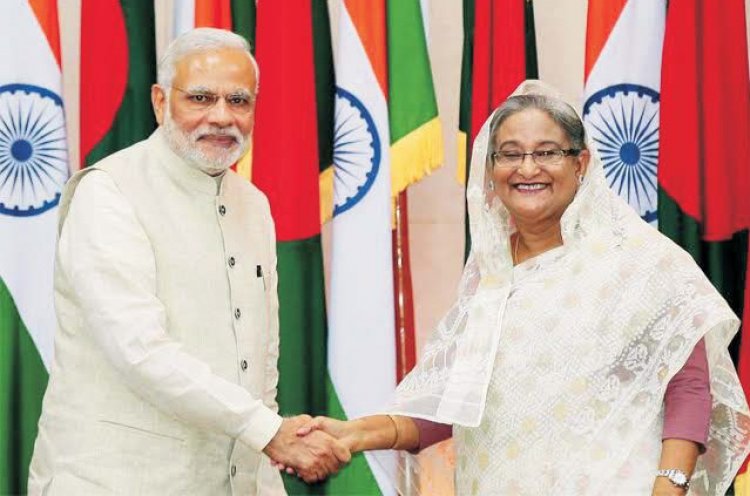India and Bangladesh: A Durable Friendship
Amulya Ganguli

Having played a seminal role in Bangladesh’s liberation in 1971, it was only to be expected that the Indian prime minister will be the chief guest at the celebrations marking the 50th anniversary of the occasion.
It was also natural that the prime minister of Bangladesh, Sheikh Hasina, will accompany Narendra Modi to the various functions not only because she is the daughter of the founder of her country, Sheikh Mujibur Rahman, but also because she escaped the assassination of Mujib and other members of his family in 1975 since she was in India on the fateful day.
Hasina’s connection with India, therefore, has deep roots. It is one of the reasons why she has always been considered pro-India by her opponents in Bangladesh, especially by her main adversary, Begum Khaleda Zia, the widow of the army officer who led the coup against Mujib.
Khaleda is the leader of the Bangladesh Nationalist Party (BNP), which is the primary political opponent of Hasina’s (and Mujib’s) Awami League although it has lost its earlier prominence. When Khaleda was in power, her party was seen as anti-India unlike the Awami League.
It is possible that this anti-Indian trait in Bangladeshi politics was behind the riots which marred Modi’s visit and led to attacks on temples. As these unfortunate events showed, Islamic fundamentalism remains a potent force in Bangladesh even if it is currently mostly hidden.
But there is little doubt that if the BNP gains ground, the Islamic militants will come to the fore again, endangering Bangladesh’s secular ethos and the lives of the Hindu minorities.
For all the present bonhomie, therefore, between Delhi and Dhaka, it is necessary to remember that the current friendship may not last forever and can fall prey to the machinations of those who remain unconvinced about Mujib’s secular vision. It is a chink in the latter’s armour which can be exploited by Islamic fundamentalists, notably of Pakistan.
However, Bangladesh’s present proximity to India is not only the result of their shared stress on a multicultural outlook, but also the abiding cultural links with West Bengal based on a common language and Rabindranath Tagore’s musical heritage. It is one of the marvels of this relationship that some of the most prominent singers of Rabindra Sangeet today come from Bangladesh and have a large number of admirers in West Bengal.
Though not as wide in range as the connections relating to Tagore’s songs and dance dramas, Bangladeshi poets and writers also have their fans in West Bengal although one of them, Taslima Nasreen, had to flee from her native land on being threatened by jehadis who did not like her outspoken criticism of their male-centric faith.
Bangladeshi films, too, are being seen and admired by an increasing number of viewers in West Bengal and India mainly via Netflix and other OTT platforms because of their artistry. To those Bengalis who see them on India’s side of the border, the films are a poignant reminder of the essential oneness of their province with its lush greenery and broad rivers which has now been disrupted as Taslima Nasreen mourns in her one of her poems.
Undeniably, the bond of this emotional unity is strong enough to withstand any rupture caused by the anti-Hindu riots in protest against Modi’s visit on the plea that the Muslims in India are not safe. Similarly, the resilience of the cultural ties, even if these are mainly between the two halves of Bengal, can brush off the occasional bumps in mutual relations caused by the description of illegal Bangladeshi immigrants by Indian politicians as “termites”.
However, the steady improvement in Bangladesh’s socio-economic conditions means that India will not have to be concerned much longer about the entry of aliens from Bangladesh in search of livelihood. As in the case of cricket, the unevenness of developmental scene in the two countries is disappearing. Just as the Bangladeshi cricketers have come of age with several of them playing stellar roles in the Indian Premium League, the economies of the two countries are entering a phase of equilibrium.
From being a “basket case”, as Henry Kissinger derisively described Bangladesh after it won the war against Pakistan, Bangladesh has now reached a stage where its GDP exceeds India’s. The jump in its economy has been the result of several factors – large remittances from Bangladeshis living abroad amounting annually to $ 15 billion, the success of its garment industry which generates 80 per cent of the country’s export income and giant strides in improving health facilities, especially for women which has reduced infant mortality.
Notwithstanding Bangladesh’s economic success, concern has been voiced about two issues – the excessive dependence on the garment industry and the government’s authoritarianism. As is obvious, an economic downturn in any of the countries which import clothes from Bangladesh can be worrisome for the latter. In this context, Dhaka is believed to have asked Delhi to forgo non-tariff barriers like “stringent checks” of the garments even as it wants tariff free access to Indian markets.
On the political front, Hasina’s authoritarianism cannot but gradually undermine her reputation, especially if questions are raised about the legitimacy of the Awami League’s electoral victories as an article in the reputed journal, Foreign Policy, has done. Khaleda Zia’s 17-year jail sentence has also cast a shadow on the health of Bangladesh’s democracy.
For India, the renewed emphasis on the strengthening of ties with Bangladesh has come at a time when there are signs that India’s relations with Pakistan are also on the mend. Nothing can be better for the sub-continent if the three countries can live in peace.
















